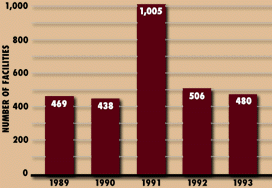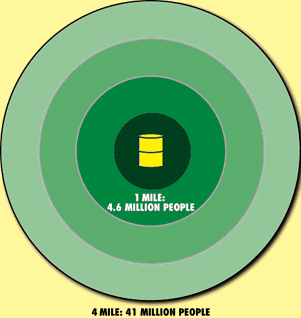

Almanac Table of Contents | Chapter Nine Table of Contents | TEC Home Page
NEXT PAGE * PREVIOUS PAGE Go to page 1*2*3*4*5*6*7*Notes

About 12,000 facilities are subject to industrial and/or hazardous waste regulations.(120) In 1993, 480 facilities or industries were cited for being out of compliance with some type of industrial waste regulation. Violations include operating without a permit; not storing waste safely; not monitoring groundwater; not determining if a waste is hazardous; and violating land disposal restrictions.(121)
If a company does not take adequate measures to remedy the problem cited in a violation, the TNRCC can seek penalties and an order requiring the company to take specific action. Most of these orders, however, are handled through a negotiation process known as an "Agreed Order." Between 1986 and April of 1994, the TNRCC issued 360 industrial waste agreed orders, requiring companies and facilities to pay nearly $11 million in fines. Because these agreements can sometimes involve a series of remedial actions as well as penalties, it can often take a year or more to fully resolve these situations.(122)

Note: The high number of violations in 1991 was due to the failure of many industries to file an annual report with the Texas Natural Resource Conservation Commission, as required.
Source: Information provided by Enforcement Section, Hazardous and Industrial Waste Division, Texas Natural Resource Conservation Commission.

Source: Testimony by Barry Johnson, Ph. D, Assistant Surgeon General, Assistant Administrator, U.S. Department of Health and Human Services, Public Health Service, Agency for Toxic Substances and Disease Registry, Before the Subcommittee on Superfund, Recycling, and Solid Waste Management, United States Senate, May 6, 1993.
| LEAD CONTAMINATION IN WEST DALLAS |
|---|
|
Superfund sites are dangerous not just because of what they contain but also because of where they are often located: near population centers. The RSR Lead Smelter in West Dallas operated from at least 1936 to 1984 as a secondary lead smelter operation, turning old lead batteries and other materials into lead. West Dallas residents were possibly exposed to dangerous levels of lead, as well as arsenic and cadmium.(132) The legacy of hazardous waste from this facility has left irreversible health effects - mainly due to lead poisoning - among African Americans and Latinos living in the vicinity of the facility.
For example, a 1985 report by the Centers for Disease Control, a federal health agency, found that children living near the RSR smelter had increased blood lead levels. A 1981 EPA study showed that lead levels in soil samples taken from people's backyards and school playgrounds near the smelter averaged nine times higher than those in soil samples taken from another area of West Dallas.(133) Lead can cause serious and permanent kidney and brain damage at high levels. Even in small amounts, lead can lead to learning disabilities, emotional disturbances and attention disorder among children.(134) Lawsuits brought by both the residents and the Texas Attorney General's Office resulted in the closing of the plant in 1984 and a $3.8 million clean-up which culminated in 1986. However, following the discovery of high lead blood levels in residents, and "hot spots" that were never properly tested or monitored, a community group called the West Dallas Coalition for Environmental Justice brought a class action suit in 1991 against the EPA in federal court. As a result, the EPA listed part of a 13-square-mile area of West Dallas as a Superfund site in 1993, and a remedial investigation to determine the extent of lead contamination has begun.(135) Residents and community and environmental groups continue to point to other polluting facilities in the area as contributing to the health problems of residents. In fact, right across the street from the old facility, the RSR Corporation continues to operate a battery crushing and lead fabrication plant. Petroleum storage facilities, an asphalt plant, a fertilizer producer, steel mills and asbestos plants are all located in this same area. Although West Dallas comprises about 15 percent of the popula-tion of Dallas County, the area produces more than 40 percent of the county's toxic air pollution.(136) |
Long before RCRA and the Texas Solid Waste Disposal Act were passed to regulate the storage and disposal of hazardous waste, manufacturing industries, the national defense industry and the oil and gas exploration and production industry were producing and disposing of hazardous waste. Many of these waste disposal sites, as well as production facilities, have closed down, been abandoned or changed ownership several times, often without the new owners fully understanding what they have inherited. Not surprisingly, these abandoned and near-abandoned waste sites have contaminated groundwater and surface water and caused adverse human health effects. The Comprehensive Environmental Response, Compensation and Liability Act (CERCLA) was passed by Congress in 1980 to provide funding to clean up these facilities and waste sites. Since then, Congress has twice reauthorized CERCLA, increasing funding from $1.6 billion to $12.1 billion.(123) These funds are to be used to help clean up abandoned and closed hazardous waste sites which are placed by the Environmental Protection Agency on a "National Priorities List."(124)
As of May 1993, there were 1331 dump sites on the national Superfund list, as well as many thousands of sites which are of a lesser priority.(125) Industrial solvents are present at 87 percent of Superfund sites; inorganic compounds, including lead, at 87 percent; and pesticides at 50 percent of the sites.(126) All told, 41 million people live within four miles - and 4.6 million people live within one mile - of one of these top priority dump sites.(127) Millions more live near other abandoned sites.
By the end of 1993, there were 30 sites in Texas on the National Priority List. In addition, the Texas Legislature amended the Solid Waste Disposal Act in 1985 to create the State Superfund Program. If a site is not eligible for the national list, it can become part of the State Superfund Program. As of March 1995, there were 42 sites on the State Superfund Registry. Finally, there are another 2,300 closed or abandoned sites which are being screened for Superfund eligibility.(128) Sixty sites have already been determined as eligible for either the state or federal Superfund list, and that number may increase to 150 over the next 20 years.(129) Most of the abandoned waste and production facility sites in Texas are related to the production of oil and gas or the chemical industry.(130)
Unfortunately, the federal Superfund program has not resulted in the expected rapid restoration of abandoned dump sites. Nationwide, on average it has taken about 2.5 years for the first stages of the clean-up process to begin.(131) During this phase, the Superfund program attempts to locate responsible parties - those who actually produced, transported or disposed of hazardous waste in an unsafe manner - and make them pay for remediation and restoration. This often results in long legal battles. If the responsible parties are unable or unwilling to fund clean-up, or if they can't be found, the federal government will pay.(141) As of March 1994, only 224 of the 1331 sites on the National Priorities List had been cleaned up, costing an average of $30 million each, much of the cost in legal fees.(142)
In Texas, the state Superfund program has also had its share of problems. Until 1991, the state did not have a reliable mechanism in place to fund its Superfund efforts. By January 1995, restoration had begun on only two of the 42 sites on the State Superfund Registry.(143) However, most of these sites are in various stages of investigation, and some have qualified for emergency, short-term removals prior to long-term remediation and closure efforts. The State Superfund program is funded by fees on lead batteries and on tonnage deposited at hazardous and industrial solid waste facilities.(144) The state spent a total of $22.13 million in FY 1993 and FY 1994 to begin the clean-up process at those sites where a responsible party cannot be held accountable.(145)
An estimated $172 million in federal funds will be spent in Texas at national Superfund sites between 1992 and 1995.(146) At one site - the Sikes Disposal Pits in Harris County - nearly $80 million from the federal Superfund will be spent to manage and dispose of soils and sludges contaminated with petrochemical waste from the 1960s.(147)
Source: Texas Water Commission, Briefing Report on Federal and State Superfund Programs in Texas for Texas Water Commissioners (Austin: TWC, May 1992), Appendix IX, 13.
Abandoned hazardous waste sites are an important priority because of their potential to cause serious environmental harm and risks to human health. All of the state and federal sites are subject to groundwater monitoring. The TNRCC has confirmed that 25 of the sites on the federal Superfund list and thirteen of the state-listed sites have already contaminated groundwater with such poisons as arsenic, lead, chromium and PCBs.(148) Groundwater contamination has also been confirmed at an additional 38 abandoned waste sites that are not on either the state or federal Superfund list.(149)

NEXT PAGE * PREVIOUS PAGE Go to page 1*2*3*4*5*6*7*Notes

Please send questions, comments, or problems with this page to ltarver@mail.utexas.edu.